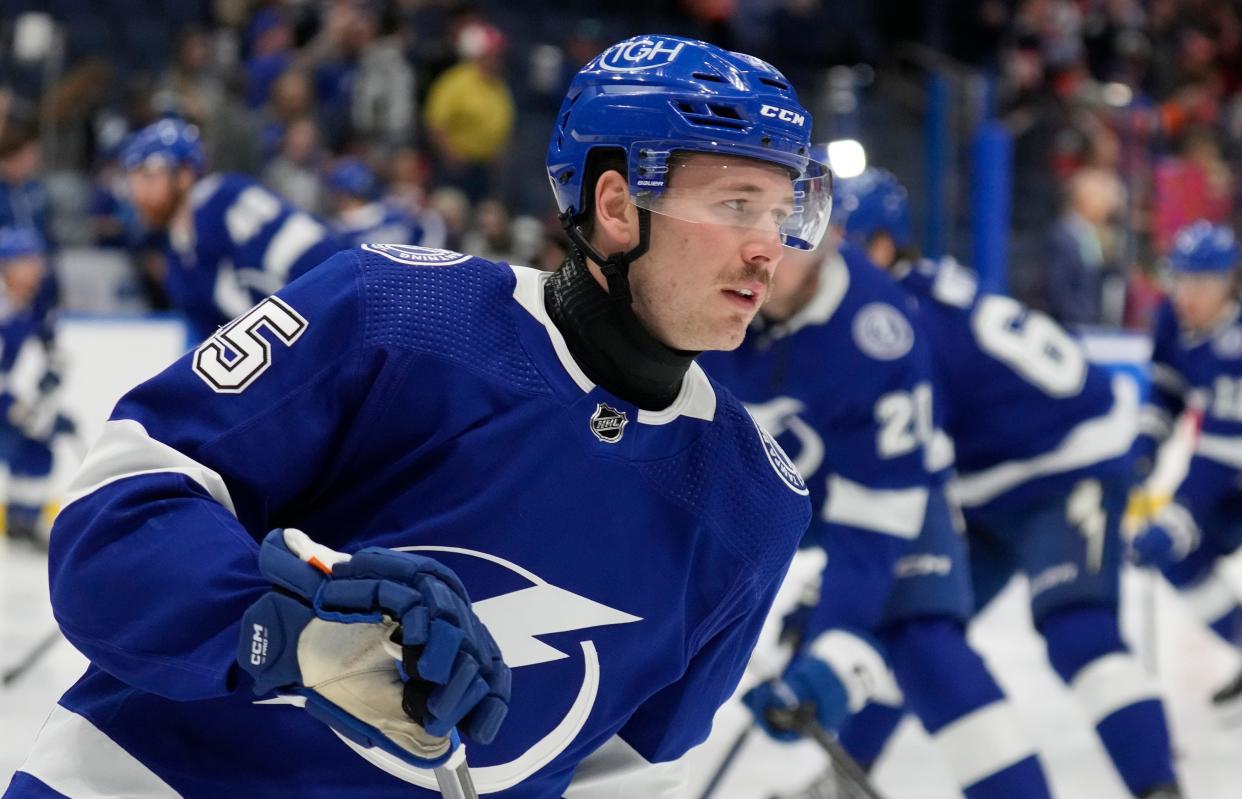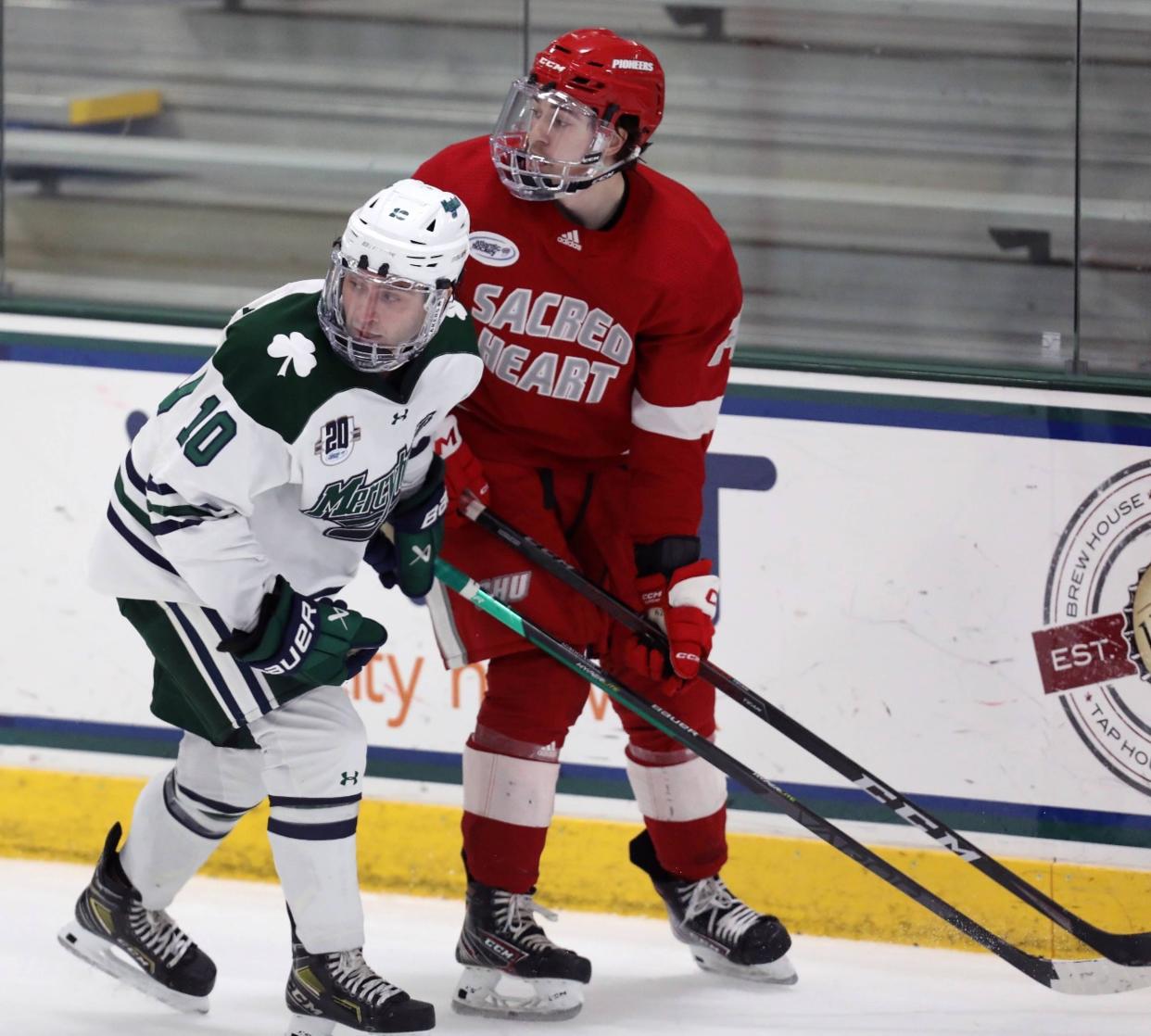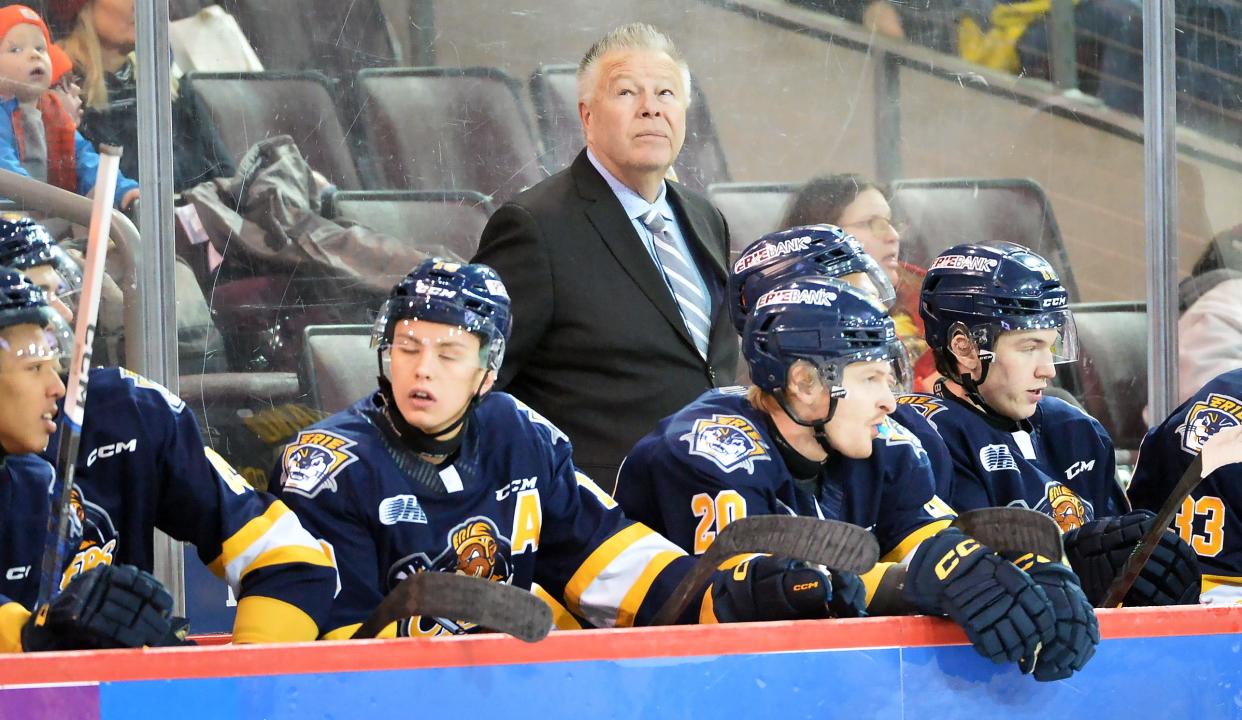Dangers on the ice: Erie-area hockey coaches, players advocate for neck protection
Rick Gotkin considers himself blessed.
Not once during five decades in hockey has the coach for the Mercyhurst University men’s team witnessed an on-ice death like Adam Johnson's.
Johnson, whose seven-year professional playing career included 13 games with the NHL’s Pittsburgh Penguins, was competing in England for the Nottingham Panthers in their Oct. 28 Elite Ice Hockey League game against the Sheffield Steelers.
Midway through play, Johnson collided with Sheffield’s Matt Petgrave. Their impact caused Petgrave’s left leg to fly upward at the same time Johnson began to fall after he was checked by another player.
The blade from Petgrave’s left skate sliced Johnson’s throat. The Grand Rapids, Minnesota, native collapsed seconds later.
Johnson was rushed to a nearby hospital but was pronounced dead hours later. He was 29.

Gotkin, 64, also deems himself fortunate he's never seen only less gruesome on-ice incidents like that of Clint Malarchuk.
It was during a March 22, 1989, NHL game between the St. Louis Blues and Buffalo Sabres when a skate of the Blues' Steve Tuttle sliced the neck of Malarchuk, the Sabres goaltender, during a scrum near the crease.
Malarchuk’s carotid artery was severed, and his jugular vein partially torn. He lost more than a liter of blood and required more than 300 stitches to close a 6-inch cut.
Malarchuk remarkably recovered and returned to Buffalo’s active roster less than two weeks later.
However, it was news of a similar on-ice injury 10 months before Johnson’s death that finally got Gotkin’s full attention. That’s when Army forward Eric Huss was cut on the right side of his neck by an errant skate blade during the Black Knights’ game against Connecticut’s Sacred Heart University.
Gotkin was familiar with those teams, if not the players involved. Army and Sacred Heart, like Mercyhurst, are Atlantic Hockey members.

“At that point I said, ‘You know, this seems to be happening a lot more,’” Gotkin said. “I immediately thought it was time we started talking about (cuts to the neck). The conversation was started, but tragically it was (Johnson’s death) which brought that to the forefront.”
Gotkin discussed the issue of neck protection for all hockey players after Mercyhurst's Jan. 26 home game against Massachusetts’ Holy Cross University.
Two days later, USA Hockey announced all its sanctioned players in age 18-and-under divisions will be required to wear neck protection during games and practices as of this August.
Johnson’s death fast-tracked the decision, according to USA Hockey executive director Pat Kelleher.
“I know throughout our organization, the overwhelming opinion was the time is appropriate to modify our rules related to neck laceration protection,” Kelleher said in a news release. “We’re also encouraged the hockey industry is committed to continuing to work to improve cut-resistant products that protect players and help influence the safest possible landscape for the game.”
Kelleher’s comment about USA Hockey’s decision was diplomatic compared to Gotkin’s description about why hockey players require neck protection.
“These guys ― and girls ― are skating on razors,” he said. “We protect our hands, our heads, our shins and our feet.”
Gotkin then made a slicing motion to his neck.
“But that … that’s wide open.”
‘So worth wearing’
Steven Agriogianis, one of Gotkin’s current players, was ahead of the neck protection curve.
Agriogianis is a senior forward who transferred to the Lakers from Northeastern University. He’s mostly donned a neck guard since his days skating for Delbarton High School in Morristown, New Jersey.
The New Jersey State Interscholastic Athletic Association mandated neck protection for its hockey players in 2013. Required or not, though, Agriogianis said his parents prohibited him from competing if he didn’t wear some sort of protective device.

“I stopped wearing one when I went to (junior hockey), but restarted when I went to college,” Agriogianis said. “When (Johnson’s death) happened, it was a no-brainer why I went back to it.”
Agriogianis wears a protective undergarment that’s not always visible but does have Kevlar woven into the fabric.
Stephanie Kwolek, a Pittsburgh-born chemist who died in 2014 at age 90, is credited as Kevlar’s inventor in 1965. It’s a synthetic fiber that heavily deters, if not fully prevents, physical harm to the wearer.
Agriogianis typically wears a Kevlar neck guard.
“It feels restrictive at first,” he said, “but once you’re out there you don’t realize at all you’re wearing it. Even if it is uncomfortable, it’s still so worth wearing.”
More: Rookie goalie Charlie Burns plays like veteran during Erie Otters' win against Guelph
Club status
Mercyhurst also sponsors a club hockey team, as does Gannon University. While such programs aren’t NCAA-sanctioned, that doesn’t mean its players are immune from such life-threatening cuts to the neck.
Jason Glover serves as Gannon’s general manager. The Golden Knights are members of College Hockey East and the Upstate New York Collegiate Hockey League.
Glover said neither association currently requires its players to wear neck guards.
However, he all but guaranteed one is imminent.
“We’re also members of USA Hockey,” Glover said. “Now that they’ve gone down that road, we expect (neck guard) requirements in the future. I don’t think there would be too big of a problem with it especially in light of (Johnson’s death).”
“The other thing for us is if it’s mandated, the players would be used to it by the time they get to college.”
High school status
The Pennsylvania Interscholastic Hockey League, the state’s governing body for high school hockey, has required its players to wear neck guards since 1999.
The league, though, became even stricter after Huss was injured, according to rules interpreter Kathy Santora.
“There’s a warning to each bench (before games),” she said. “The referees are to issue a 10-minute misconduct to any player who isn’t wearing such protection.”
“We've had times where that’s happened and (safety issues) have faded. In light of Johnson’s death, we hope that doesn’t happen again.”
Santora also is affiliated with USA Hockey. She said the organization regretted it couldn’t mandate such protection before now because of a lack of established criteria.
Youth status
Although Ken Wolfarth has never met Agriogianis, they share a background. Each are New Jersey natives and played high school hockey in the Garden State.
Wolfarth, 43, is in his second term as president of the Erie Youth Hockey Association. While he wasn’t associated with them 35 years ago, the organization required neck protection for all its players within days of Malarchuk’s injury.
“I can tell you the EYHA is thrilled with (USA Hockey’s) move to neck guards,” Wolfarth said.
The EYHA’s decision 35 years ago forced parents of its players to purchase protective neckwear. Some teams do own spares according to Wolfarth, but not enough for an entire roster.
Amazon.com is a natural starting point for online purchase of those garments.
Neck protection-only items on Amazon.com were listed at $19.95 recently. Upper-body protection went for $59.95.
Purehockey.com, a site which specializes in equipment for the sport, listed the Shock Doctor Ultra 2.0 for youth players at $19.99. A neck guard bib for older players ran for $34.99 and a full-body, cut-resistant undergarment for $139.
Wrist guards separately went for $35.99.
“I know a lot of our players have gone to the built-in shirts,” Wolfarth said. “They’re easier to wear and there’s no excuse for forgetting them because you’re always wearing one.”
Because of the existing precautions, combined with USA Hockey’s impending mandate, Wolfarth doesn’t expect parents of players to be deterred from sending their children on the ice in light of Johnson’s death.
“People will read the facts of what happened,” he said, “which is the way it should be.”
OHL long on board
The Erie Otters have competed in the Ontario Hockey League since 1996. It features elite young players who are annually chosen during the NHL draft.
Connor McDavid, a three-time most valuable player for the Edmonton Oilers, is the Erie franchise's greatest alumnus.
The OHL is one of three major junior leagues that comprise the Canadian Hockey League. The others are the Quebec Major Junior Hockey League and the Western Hockey League.
The OHL and QMJHL had neck protection requirements in their rule books long before this season.
The CHL became pure in that sense when the WHL made them mandatory this past Nov. 1, three days after Johnson’s death.

Otters coach Stan Butler, whose OHL coaching career dates to 1994, is beyond committed when it comes to neck protection mandates. He shuddered to think of such injury occurring to his children, Sara and Adam.
“It makes a physical sport ― a contact sport ― a lot safer,” Butler said. “As we become more progressive with technology, the sharper skate blades make kids go at a higher (speed). We need to do as much as we can from a protection standpoint to enhance the safety of players.”
“The (OHL) is doing everything it can to make it as safe an environment as possible.”
More: How No. 1 overall OHL draft pick Matthew Schaefer is faring as an Erie Otters rookie
‘Time for action’
It wasn't until the 1979-80 NHL season when all first-time players were finally required to wear helmets.
The league also made protective eye visors mandatory in 2013-14.
Neck protection, according to Gotkin, must be next throughout the sport. He mentioned the Penguins and Chicago Blackhawks as teams that haven't waited for a decree from the NHL. Those franchises already require their minor leaguers to don neck protectors.
“The NHL Players Association has already mandated Kevlar protection behind the ankles,” Gotkin said. “I never realized guys had to wear that until recently. But they still haven’t done the neck thing. The NCAA is in a rule-change year, and I’ll bet you they’ll be talking very hard about that in the wake of (Johnson’s death).”
“The time for action is now.”
Contact Mike Copper at mcopper@timesnews.com. Follow him on X at @ETNcopper.
This article originally appeared on Erie Times-News: Death of former Pittsburgh Penguins player renews push for neck guards
